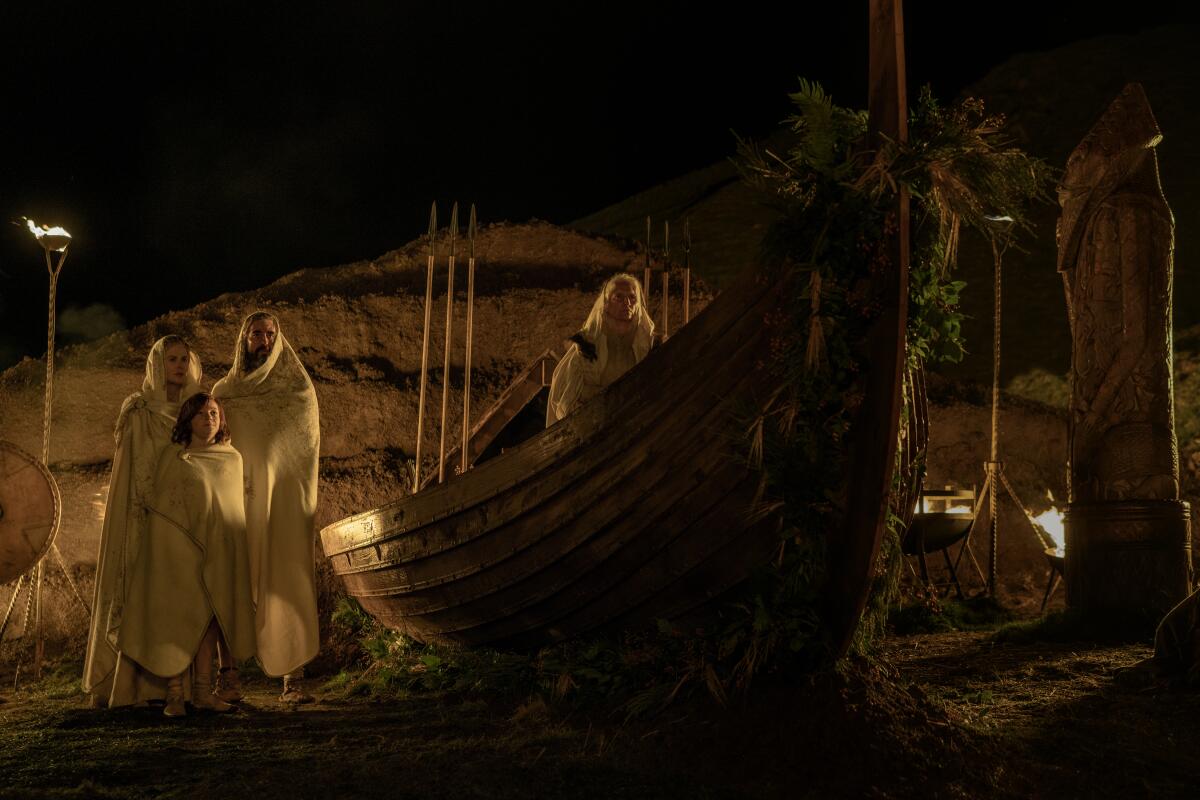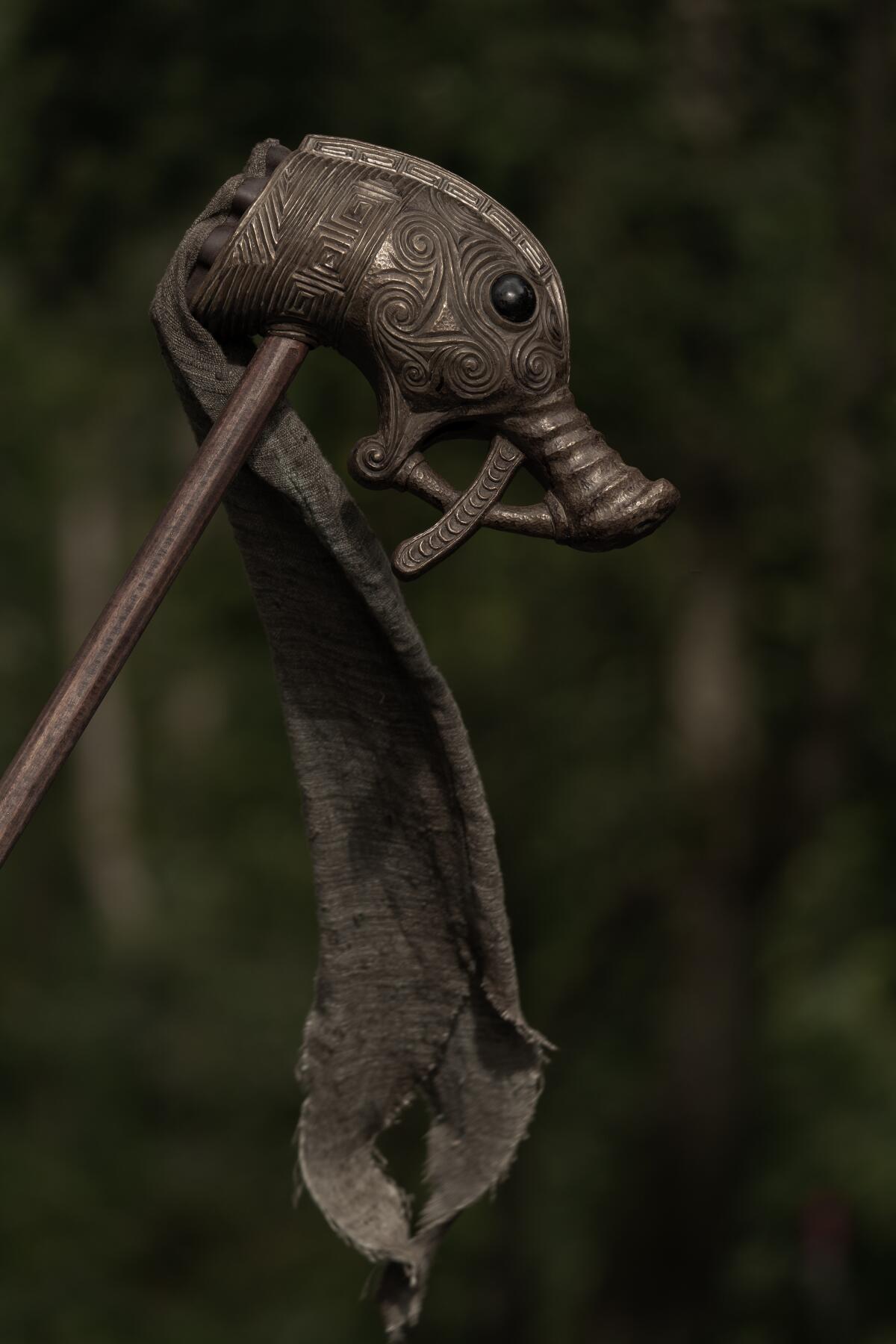Sign up for The Envelope
Get exclusive awards season news, in-depth interviews and columnist Glenn Whipp’s must-read analysis straight to your inbox.
You may occasionally receive promotional content from the Los Angeles Times.

To suggest that acclaimed filmmaker Robert Eggers continues to challenge his longtime collaborator, production designer Craig Lathrop, is something of an understatement. Their first project, “The Witch,” saw Lathrop charged with re-creating a historically accurate 17th century New England farm on an indie horror production budget. Their second endeavor, “The Lighthouse,” required the construction of an actual working 19th century lighthouse. With “The Northman,” Lathrop and his crew had an even bigger assignment: resurrect a 10th century Viking civilization from scratch — at least as much as documented history would allow them.
“There’s so much that we don’t know as we started to progress through this,” Lathrop notes. “We knew that there are columns in the middle of the long houses, but what did those columns look like? How were they carved? You just had to dig in other places to try to find what that was.”
Lathrop adds with a note of whimsy, “I didn’t know anything about Vikings before I started this. I’ve learned quite a lot. I might know a little bit too much.”
Eggers’ epic follows Amleth (Alexander Skarsgård), a lost Viking warrior, as he seeks revenge against his Uncle Fjölnir (Claes Bang) for killing his father and holding his mother (Nicole Kidman) captive against her will. Amleth’s pilgrimage finds him traveling acrosstravels from the fictional Hrafnsey to what’s now Russia and Iceland, battling frigid seas, and ends with a climactic fight on what appears to be an active volcano. For Lathrop, the biggest contest was the scope of the story, which saw the artist and his crew tasked with building three complete villages, numerous caves, several long houses and multiple temples, among other dramatic sets.
“The hardest [village] to build was probably Hrafnsey, just because it was a difficult location that we chose to build it in,” Lathrop says. “We found this place in Northern Ireland called Torr Head that we had to build a bit of a road into it, and trying to get everything up on this very windy cold spot was a bit of a challenge.”
Sex dreams about mermaids, ill-tempered seagulls who seem possessed, flatulence employed as “deliberate displays of power.” Robert Eggers’ black-and-white thriller “The Lighthouse” has much to discuss.
The designer was proudest of those Hrafnsey sets because of their detail, even if those embellishments were often on-screen for just a passing moment. The production built nine-foot, hand-carved wooden idols and commissioned period-accurate tapestries from India. Moreover, almost every piece of furniture on screen, the swords, the shields, the knives and the weaving were created just for the film. And then there were the two massive seafaring boats that took six months to build in the Czech Republic.
“I built a langskip and a knar [Viking ship],” Lathrop says. “The langskip, which is the long boat that they row in, I built that so that the ends that have this snake or the wolf’s head, I could take them off and put on another one and make it look like I had more than one boat. I could interchange some parts on them so [it would appear you] see several of them going by.”


Production initially began in March 2020 before being shut down for five months due to the COVID pandemic. Lathrop had built a key set in Ireland, Fjölnir’s farm, during what turned out to be a rare Irish drought. Luckily, he received permission to have a greensman water the sets during the break. In the end, it turned out to be something of a silver lining for the set.
“I built all of these buildings that were built out of turf,” Lathrop says. “They were actually built, like set construction, and then they were clad in actual turf, and it was coming along great. I had seeded the outside of my sets and tried to get them to look right, but they weren’t quite there when we went on COVID [hiatus]. When we came back, they were alive, they had completely grown in. In fact, I had to trim them, because they had grown so much, which was wonderful.”
The film’s tour de force is that showdown at the base of Iceland’s Hekla volcano. In reality, it was actually staged in a quarry in Ireland.

“The hard thing for me to do was get enough black sand into Ireland,” Lathrop says. “There’s not that much volcanic sand in Ireland, it turns out. I think we probably used every bit of black sand on the whole island. I have to say, that set was more fun. I thought it was going to be a real pain. But as we were there, I realized that I’m sitting here sculpting with bulldozers as we were moving sand and making the terrain look like we want it to look, which is really cool.”
Now in production on his fourth film with Eggers, a new interpretation of the horror classic “Nosferatu,” Lathrop is abiding by the important lessons taking on “The Northman” taught him.
“As daunting as it seems in the beginning, you just take little bites and you just keep going at it,” Lathrop says. “When I first read the script, I was excited. I wouldn’t say that I was scared about it, but I was nervous because I wasn’t sure where I was going to find the people to do it, who was going to do it, and all those things. Just like on every other film, they started to fall into place. You just had to push, and you had the resources to get it all done and find good people.”
Sign up for The Envelope
Get exclusive awards season news, in-depth interviews and columnist Glenn Whipp’s must-read analysis straight to your inbox.
You may occasionally receive promotional content from the Los Angeles Times.